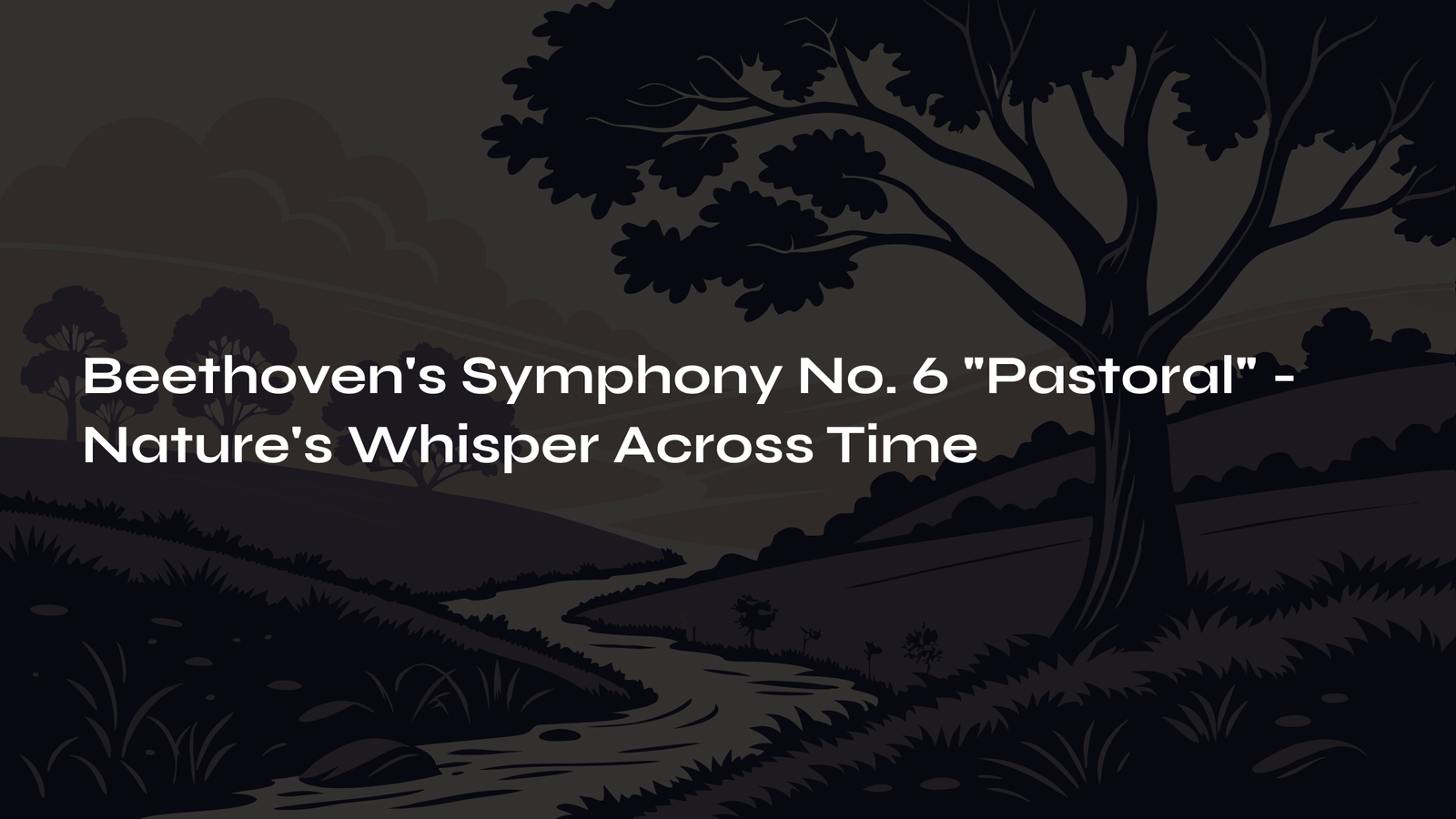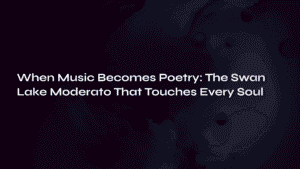Table of Contents
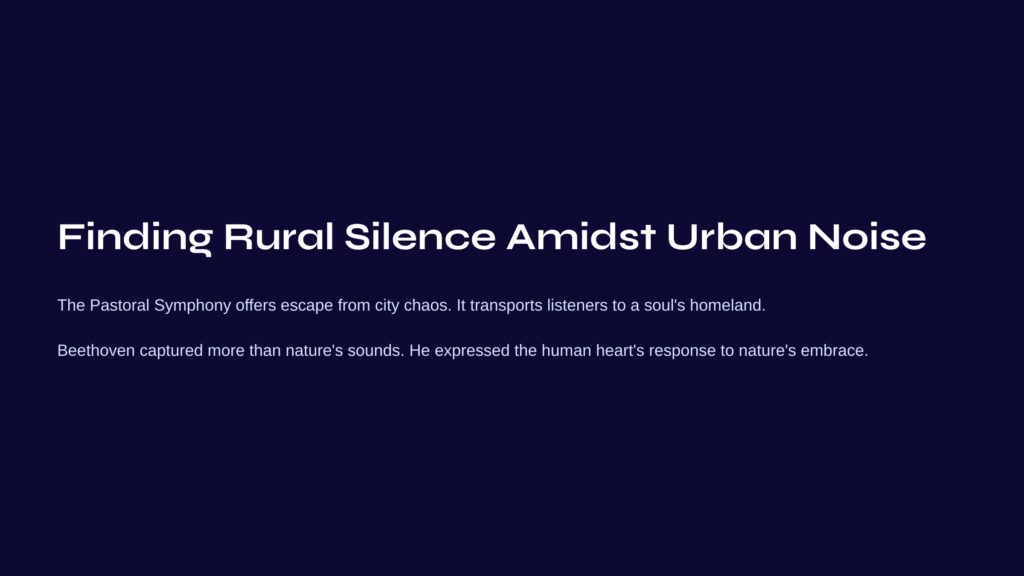
Finding Rural Silence Amidst Urban Noise
One day, my heart, weary from the city’s relentless cacophony, suddenly yearned for something: silence. In that moment, Beethoven’s Symphony No. 6, the “Pastoral,” came to mind. Every time I listen to this piece, I become a time traveler. Not to Vienna’s theater in 1808, but to somewhere much more distant—to a landscape like a hometown hidden deep within my soul.
What Beethoven embedded in this music wasn’t a simple depiction of nature. It was the human heart gazing upon nature, the waves of emotion that arise within. Unlike the fierce intensity of the Fifth Symphony, this music embraces us like a soft, warm sanctuary where we all become children again.
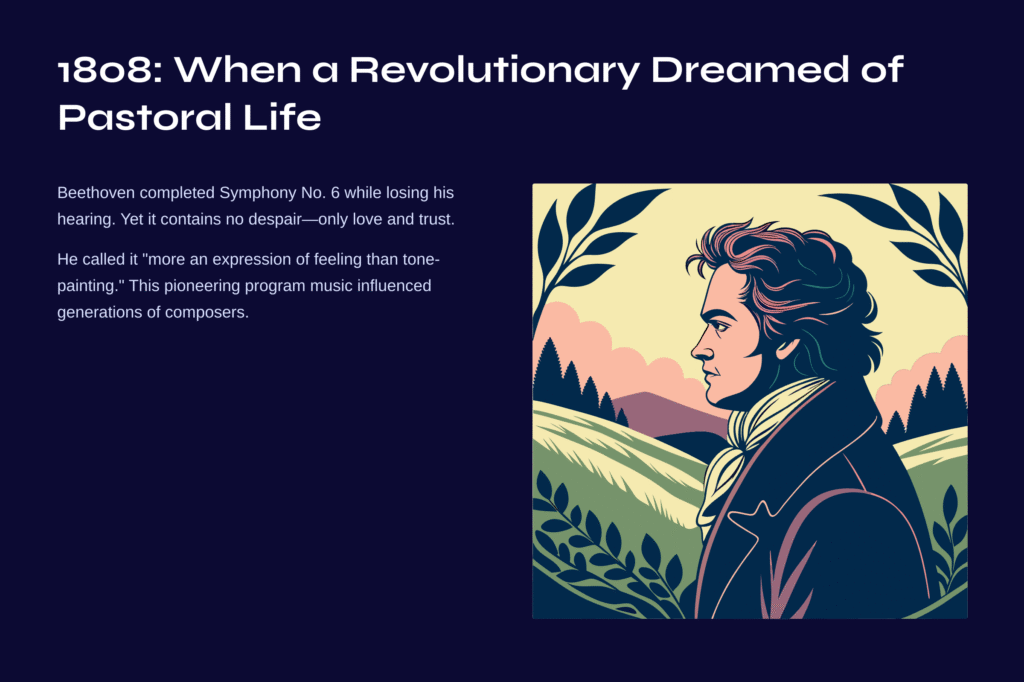
1808: When a Revolutionary Dreamed of Pastoral Life
Ludwig van Beethoven completed his Symphony No. 6 in 1808, during a period when he was already losing his hearing and feeling profound frustration with communication with the world. Yet in this work, we find no shadow of such despair. Instead, it overflows with infinite love and trust in the world.
Beethoven himself gave it the subtitle “Pastoral Symphony, or Recollections of Country Life,” emphasizing that this music was “more an expression of feeling than tone-painting.” In other words, his purpose wasn’t to imitate birdsong or describe streams, but to transform into music the pure emotions humans feel in the presence of nature.
This work is celebrated as an early masterpiece of program music. It paved the way for later works like Berlioz’s Symphonie Fantastique, Liszt’s symphonic poems, and Smetana’s “Má vlast.” However, Beethoven’s approach was remarkably restrained and elegant.
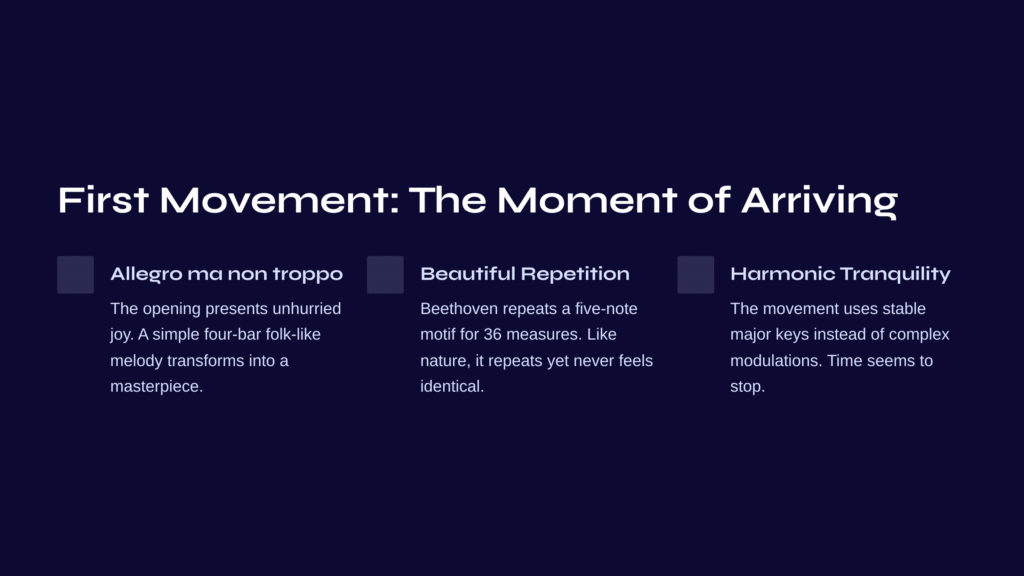
First Movement: The Moment of Arriving at the Heart’s Countryside
Allegro ma non troppo – Unhurried Joy
The first movement bears the descriptive title “Awakening of cheerful feelings upon arrival in the country.” Beethoven’s tempo marking, Allegro ma non troppo (fast, but not excessively so), perfectly encapsulates this music’s character. Unhurried joy, patient excitement—this is the very essence of the music.
The opening melody in F major is surprisingly simple. The four-bar theme presented by the first violins possesses a folk-like familiarity. Yet Beethoven crafts a nearly 30-minute masterpiece from this simple tune. The secret lies in the “magic of motivic development.”
Discovering Infinite Beauty Through Repetition
The most striking aspect of this movement is its development section. Beethoven repeats the same five-note motif for an astounding 36 measures, then continues with the same material for another 36 measures. What might have induced tedium in another composer’s hands becomes hypnotic beauty under Beethoven’s touch.
This resembles nature’s patterns. The rhythm of waves against the shore, the whisper of leaves swaying in the wind, the chirping of birds… Nature constantly repeats yet is never identical. Beethoven captured this infinite similarity and infinite variety of nature in music.
Harmonic Tranquility
The harmonic progression in the development section is equally distinctive. Typical symphonies employ complex modulations and dissonances in the development to create conflict and tension. But the Pastoral Symphony uses only stable major keys—B-flat major, D major, G major, E major. This was an intentional choice. Beethoven wanted to create a time of peaceful meditation rather than musical conflict.
Such harmonic stillness gives the impression that time has stopped. As we listen, we pause our steps in nature, look around, and take a deep breath.
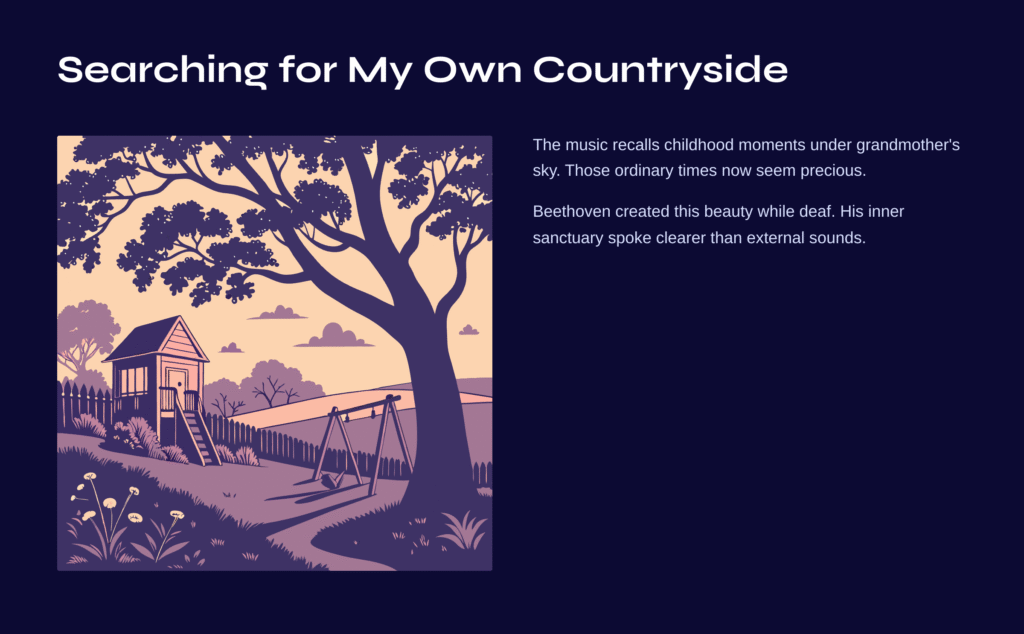
Searching for My Own Countryside
Every time I hear this music, I recall the sky I gazed upon from my grandmother’s yard as a child. I didn’t know then how precious those seemingly ordinary moments were. Beethoven’s first movement returns those lost times to us.
As the music flows, I’m drawn deeper and deeper. The weight of reality vanishes, and “my own countryside,” treasured in a corner of my heart, unfolds. There, time flows slowly, everything is gentle, and worries remain distant.
That Beethoven could create such beautiful music while losing his hearing was perhaps because he too had such a sanctuary within his heart. Though he couldn’t hear the sounds of the external world, the voice within him must have been clearer than ever.
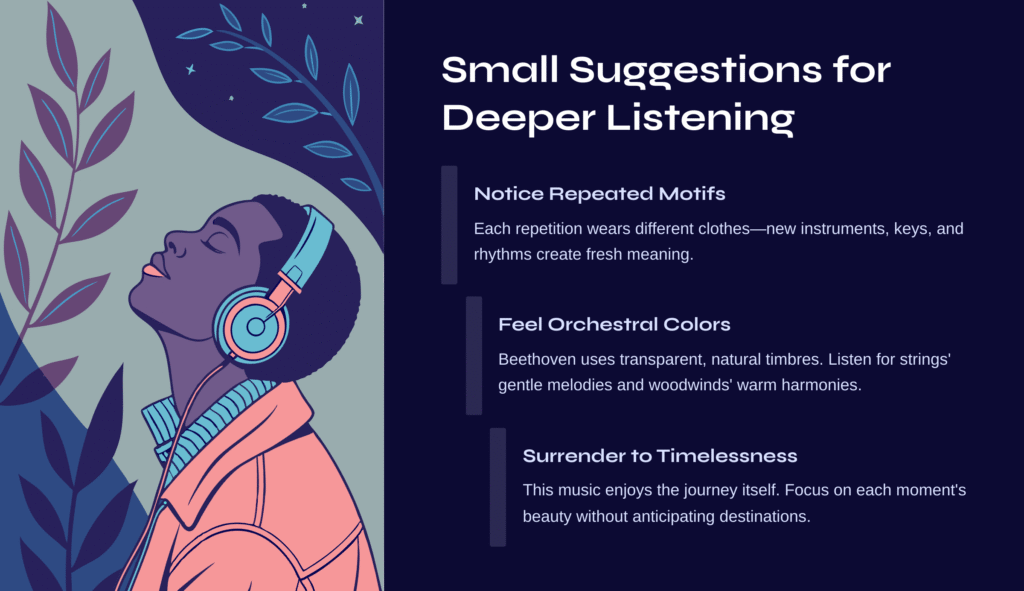
Small Suggestions for Deeper Listening
If you wish to appreciate this music more deeply, I’d like to offer a few recommendations.
First, pay attention to the repeated motifs. Each time the same melody appears, you’ll discover it’s wearing slightly different clothes. Sometimes performed by different instruments, sometimes in different keys, sometimes with different rhythms, it gains new meaning through variation.
Second, feel the orchestra’s delicate colors. In this work, Beethoven pursued transparent and natural timbres rather than massive sonorities. Listen carefully to the overall sonic palette created by the strings’ gentle melodies, the woodwinds’ warm harmonies, and the restrained use of brass instruments.
Finally, surrender yourself to the music without being conscious of time’s passage. This isn’t music that races toward a destination but music that enjoys the journey itself. Don’t wonder where it’s going; focus only on the beauty of the melody flowing in this moment.
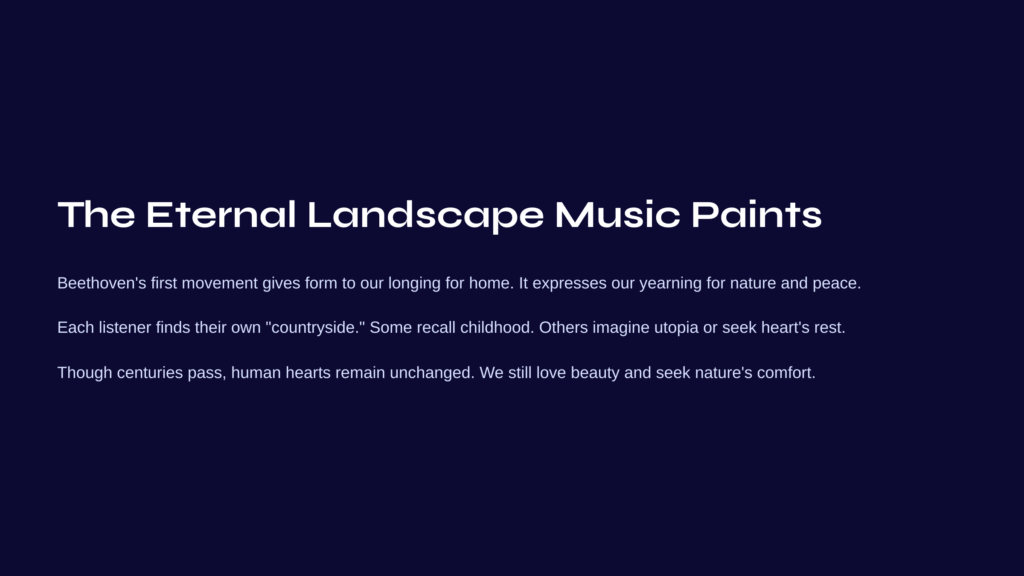
The Eternal Landscape Music Paints
The first movement of Beethoven’s Pastoral Symphony isn’t merely music depicting rural scenery. It’s a work that gives musical form to the longing for home deep within the human heart, our yearning for nature, and our earnest wish for peace.
Listening to this music, each of us encounters our own “countryside.” For some, it will be childhood memories; for others, a dreamed-of utopia; for still others, a resting place that soothes the weary heart. This is why the music Beethoven created 200 years ago still moves our hearts today.
Though time passes, the human heart remains unchanged—the heart that loves beauty, yearns for peace, and seeks comfort in nature. Beethoven’s Pastoral Symphony is an eternal masterpiece that musically celebrates such unchanging human nature.
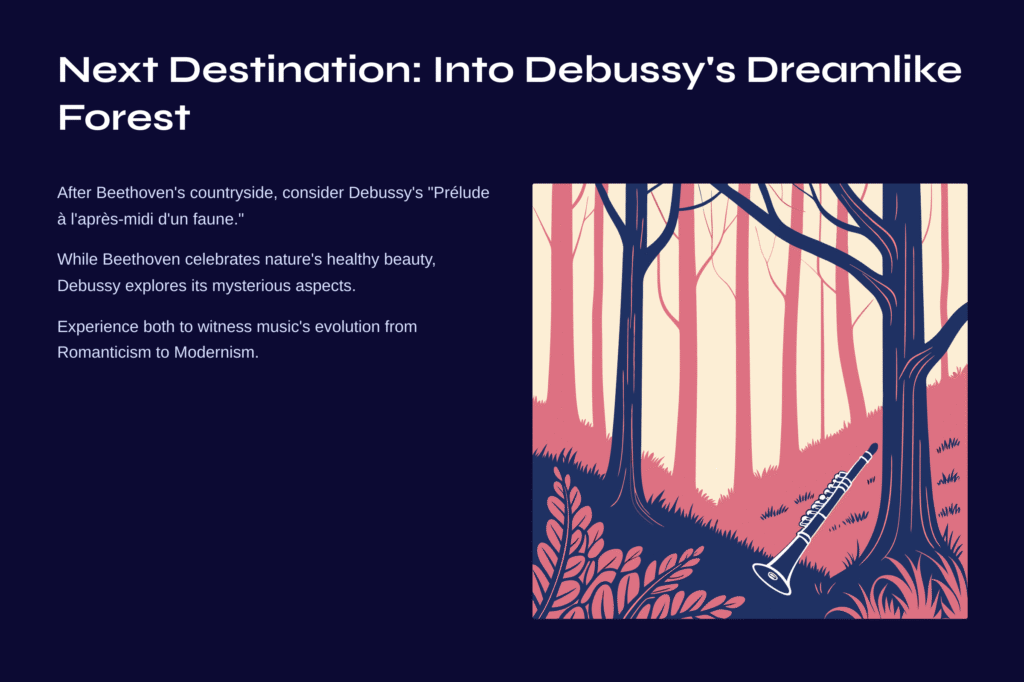
Next Destination: Into Debussy’s Dreamlike Forest
Having found peace of mind in Beethoven’s countryside, how about venturing into a more fantastical world? I recommend Claude Debussy’s “Prélude à l’après-midi d’un faune” (Prelude to the Afternoon of a Faun).
Completed in 1894, this work reveals a completely different world from Beethoven’s clear, warm nature. Inspired by Stéphane Mallarmé’s poetry, this music depicts the sensual and mysterious dream of a faun from Greek mythology. Beginning with the famous flute solo, this piece became the starting point of Impressionist music and a revolutionary work that changed the course of music history.
While Beethoven sang of nature’s healthy beauty, Debussy explored nature’s mysterious and fantastical aspects. Instead of clear melodies, he uses color and atmosphere; instead of definite rhythms, he employs wavelike flows to guide us into another dimension of nature.
If Beethoven’s pastoral represents “moral and wholesome” nature, Debussy’s forest embodies “mysterious and sensual” nature. Listening to both works consecutively will vividly reveal the differences in how different eras and cultures view the same nature. It will be a special time to directly experience the turning point in music history from 19th-century Romanticism to 20th-century Modernism.
